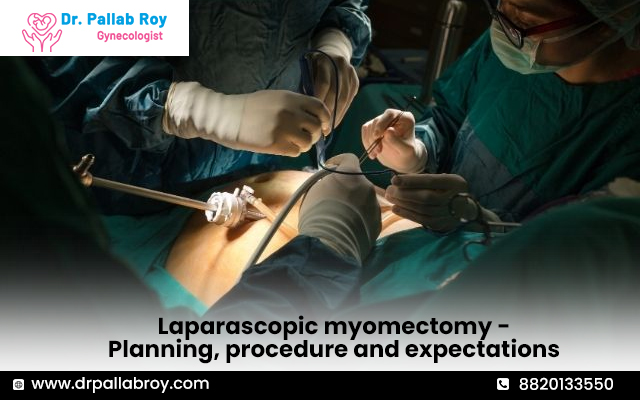Undergoing a laparoscopic myomectomy offers a much faster recovery time as well as leaves slight scarring. It allows the removal of uterine fibroids that are also known as leiomyomas, through tiny incisions. They may cause heavy periods and pain. The top laparoscopic myomectomy surgeon in Garia uses advanced techniques and upgraded technology, transforming uterine fibroid surgery into a smooth and less troublesome experience.
Planning
- Consultation
An appointment should be scheduled with a specialist with whom you can speak regarding your medical history, symptoms and the options for treatment.
- Evaluation
An in-depth preoperative evaluation, including a physical examination, some blood tests, an ultrasound of the pelvic region and some other tests, will be done to check your health and identify the number and location of the uterine fibroids.
- Preparation before surgery
Follow instructions to prepare yourself before surgery. This includes guidelines to fast before surgery, avoiding certain medications and bowel preparation instructions if required.
- Post-surgery guidelines
Post the surgical procedure, you will be monitored until you regain consciousness and are fully stable. Instructions will be given on care and recovery, pain management, restrictions to specific activities and diet maintenance.
- Follow-up
Do not miss any follow-up appointments that are required to monitor your progression in recovery, check for any complications and have long-term treatment discussions.
Procedure
Here’s a summary of the usual steps involved in the procedure of laparoscopic myomectomy –
- Anesthesia
In the operation theater, during the procedure, anesthesia is given to ensure that you are unconscious and free from pain.
- Incisions made in the abdomen
Tiny incisions are made in the abdomen. Hollow tubes with valves are placed through these incisions. These tubes act as a passageway for laparoscopic instruments and cameras.
- Carbon Dioxide
To create space and enhance visualization of the area of surgery, carbon dioxide gas is pumped into the abdomen.
- Laparoscope insertion
A thin tube with a camera and source of light, called a laparoscope, is inserted. This is done to get a magnified view of the abdomen on a monitor.
- Fibroid identification and removal
The laparoscope is used for careful inspection of the uterus and identification of the fibroids. From this, the location and amount of fibroids present can be concluded. After this, medical instruments are used to remove the fibroids. Top laparoscopic myomectomy doctor in South Kolkata uses state-of-the art technology to ensure the success of this procedure.
- Incision closure
Post removal of fibroids, incisions are closed.
- Care post-surgery
After the surgery, instructions regarding taking care of your wounds and managing pain will be provided. You will also be given dates to do follow-ups.
Expectations
Here are some expectations to take into consideration –
- Relief from fibroid-related symptoms
- Fertility preservation
- Long-term outcome that you can discuss with your gynaecologist.
Conclusion
Laparoscopic myomectomy has several benefits for women suffering from uterine fibroids. It aims to provide relief from symptoms like heavy menstrual bleeding, pain in the pelvic region and pressure. The skilled laparoscopic myomectomy surgeon in Garia helps you regain the quality of life post your fibroid surgery with utmost confidence.

